Ryanair Holdings Bundle
Who Flies Ryanair, and Why Does It Matter?
Ryanair, a titan of the European skies, has built its empire on understanding its customers. From its humble beginnings challenging established airlines, Ryanair has mastered the art of identifying and catering to its target market. This deep dive explores the fascinating world of Ryanair's customer demographics and reveals the strategies that have fueled its remarkable success.
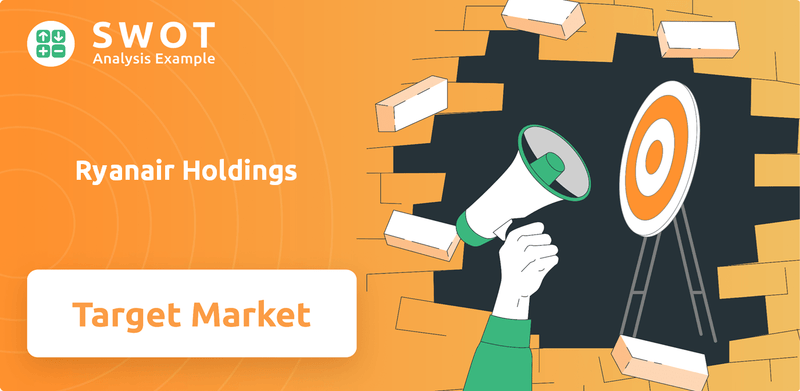
Understanding the Ryanair Holdings SWOT Analysis is crucial to grasping its strategic direction. This analysis will dissect the airline's customer profile, encompassing everything from age range and income levels to travel habits and origin countries. By examining Ryanair's market segmentation and customer behavior, we'll uncover how the airline acquires and retains its vast customer base, providing valuable insights into its marketing strategies and overall customer satisfaction.
Who Are Ryanair Holdings’s Main Customers?
Understanding the customer demographics Ryanair serves is crucial for grasping its business model. Ryanair primarily operates on a Business-to-Consumer (B2C) model, focusing on price-sensitive travelers. This approach has allowed the company to become a major player in the European aviation market. Its success hinges on accurately identifying and catering to its target market, which has evolved over time.
The Ryanair target market is primarily composed of leisure travelers who prioritize low fares. However, the airline also caters to business travelers, especially those from small and medium-sized enterprises (SMEs) looking for cost-effective travel options. The airline's strategy involves a mix of route expansion, frequency of flights, and ancillary services to appeal to a broad range of customers. This approach has enabled Ryanair to maintain a competitive edge in the budget airline sector.
The Ryanair customer profile typically includes a wide age range, with a strong emphasis on younger travelers (18-35) and families. These customers often have moderate to lower income levels. Ryanair's focus on direct routes and frequent flights appeals to these demographics. The airline's ability to offer low fares is a key factor in attracting this customer base. Ryanair aims to grow its passenger traffic to 300 million passengers annually by 2034, indicating a continued focus on expanding its customer base.
Leisure travelers form the largest segment of Ryanair's customer base. They are highly price-sensitive and prioritize affordability. These travelers often book in advance to secure the lowest fares and are willing to accept limited amenities. The airline's strategy is designed to cater to this segment by offering a vast network of routes and frequent flights.
Ryanair also targets business travelers, particularly those from SMEs. This segment values cost-effectiveness and efficient travel options. The airline's extensive network and frequent flights make it a viable choice for short-haul business trips. Ryanair has enhanced its services, such as priority boarding, to attract this segment.
The age range of Ryanair passengers is broad, with a significant portion falling between 18 and 35. Income levels vary, with a concentration in the moderate to lower brackets. This demographic is attracted by the low fares and the ability to travel frequently. The airline's marketing efforts are tailored to resonate with this demographic.
Customer behavior is largely driven by price sensitivity and a willingness to accept limited services. Booking habits often involve advance purchases to secure the best deals. Passengers are increasingly willing to pay extra for add-ons like reserved seating. Ryanair's focus on ancillary revenue reflects this shift in customer behavior.
Ryanair segments its customers primarily by travel purpose (leisure vs. business) and price sensitivity. The airline has adapted its services to cater to a broader range of needs. Ryanair's ability to understand and adapt to these segments is key to its continued success. To further understand the company's approach, you can read more about the Growth Strategy of Ryanair Holdings.
- Leisure travelers seeking low fares.
- Business travelers from SMEs focused on cost-effectiveness.
- Younger travelers and families.
- Customers willing to pay for add-ons for a more streamlined experience.
Ryanair Holdings SWOT Analysis
- Complete SWOT Breakdown
- Fully Customizable
- Editable in Excel & Word
- Professional Formatting
- Investor-Ready Format
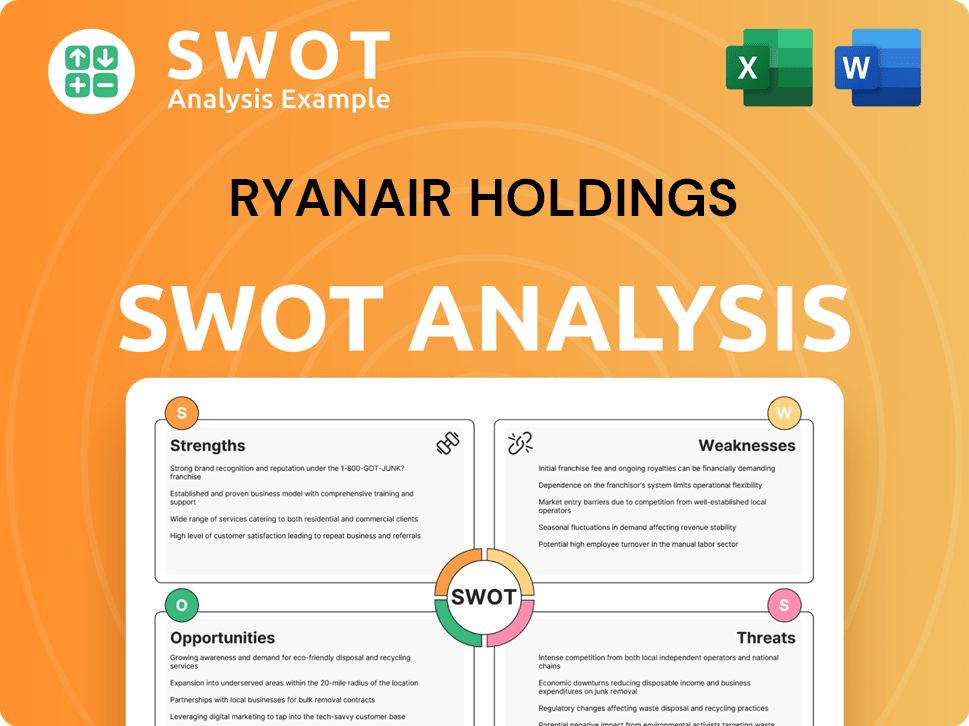
What Do Ryanair Holdings’s Customers Want?
Understanding the needs and preferences of its customers is crucial for Ryanair's success. The airline's strategy is deeply rooted in catering to a specific segment of travelers who prioritize affordability and efficiency. This focus allows Ryanair to maintain its competitive edge in the budget airline market.
The customer demographics Ryanair attracts are primarily driven by price sensitivity, convenience, and accessibility. These factors influence every aspect of the customer experience, from booking to in-flight services. By focusing on these core needs, Ryanair has built a loyal customer base.
The airline's approach to customer needs and preferences is a key element of its business model. The Ryanair target market consists of individuals and groups looking for low-cost travel options. This includes leisure travelers, budget-conscious business travelers, and those seeking point-to-point travel without the added costs of extras. Ryanair's strategy is designed to meet these needs directly.
The primary needs driving Ryanair's customers are price, convenience, and direct routes. They often book in advance to secure the lowest fares, and their decision-making is heavily influenced by flight cost and schedule. Customer behavior is characterized by a preference for minimal add-ons unless essential.
- Price Sensitivity: Customers consistently seek the lowest available fares.
- Convenience: Direct routes and frequent schedules are highly valued.
- Efficiency: Avoiding layovers and maximizing time at the destination is a priority.
- Minimal Add-ons: Customers typically avoid extra services unless necessary.
- Reliability: Consistent low fares and reliable service are key to customer loyalty.
Psychological drivers include the desire for affordable travel experiences, enabling more frequent trips or access to destinations that might otherwise be cost-prohibitive. Ryanair addresses common pain points such as high airfares and limited direct routes to secondary airports. Customer feedback, often channeled through surveys and online reviews, has influenced product development, leading to improvements in the booking process, mobile app functionality, and the introduction of flexible fare options. Ryanair has tailored its marketing to emphasize transparency in pricing and the breadth of its network, while product features like its 'Flexi Plus' fare cater to those seeking more flexibility and included services, illustrating how the company adapts to specific segment needs.
Ryanair Holdings PESTLE Analysis
- Covers All 6 PESTLE Categories
- No Research Needed – Save Hours of Work
- Built by Experts, Trusted by Consultants
- Instant Download, Ready to Use
- 100% Editable, Fully Customizable
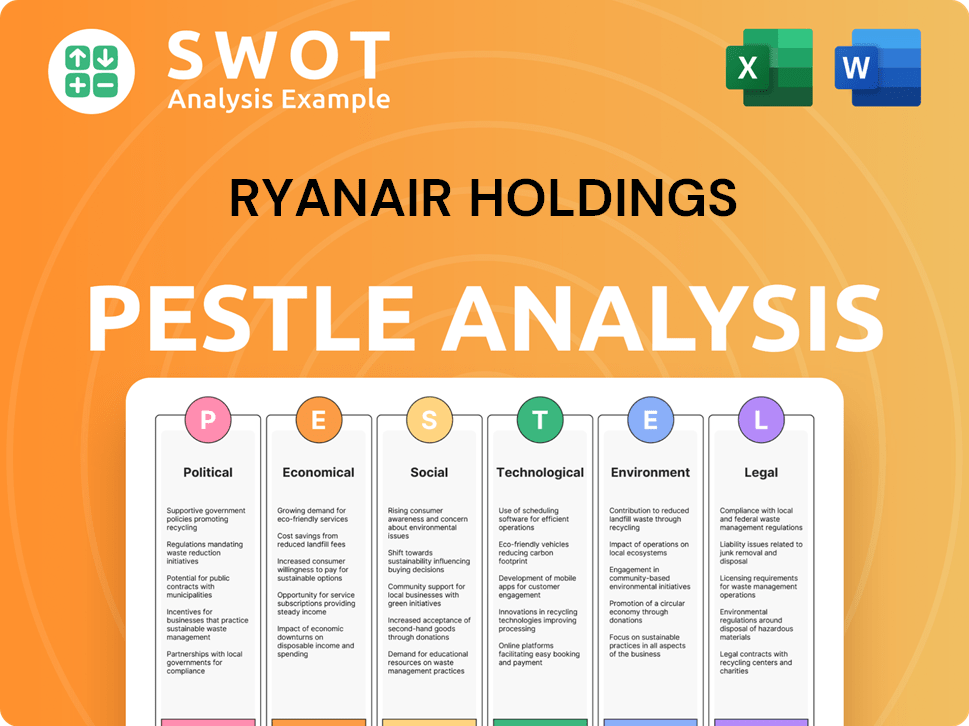
Where does Ryanair Holdings operate?
The geographical market presence of Ryanair is primarily concentrated in Europe. It operates as one of the largest airlines in the region, serving a vast network of destinations. Ryanair's strategic focus on Europe allows it to capitalize on high-demand routes and maintain its low-cost model effectively.
Key markets for Ryanair include the UK, Ireland, Spain, Italy, Germany, France, and Poland. These countries represent significant portions of Ryanair's passenger traffic and revenue. The airline's strong brand recognition and market share in these regions are critical to its overall success. Brief History of Ryanair Holdings can give you more details about the company.
While Ryanair's core customer demographic shares a common trait of price sensitivity, regional variations exist. Customers in Central and Eastern Europe may be even more price-sensitive than those in Western Europe. This impacts the airline's approach to marketing and service offerings across different regions.
Ryanair's primary focus is on the European market, with a strong presence in Western and Southern Europe. It strategically positions itself in high-traffic areas.
Subsidiaries like Lauda Europe, Malta Air, and Buzz help Ryanair tailor its services to specific regional markets. This localization allows for adaptation in language and payment methods.
Recent expansions have focused on strengthening its presence in key markets and exploring underserved routes within Europe. The geographic distribution of sales is heavily skewed towards established European routes.
In 2024, Ryanair aimed to grow its traffic to 183.5 million passengers, demonstrating its continued expansion and dominance in the European market.
Ryanair Holdings Business Model Canvas
- Complete 9-Block Business Model Canvas
- Effortlessly Communicate Your Business Strategy
- Investor-Ready BMC Format
- 100% Editable and Customizable
- Clear and Structured Layout
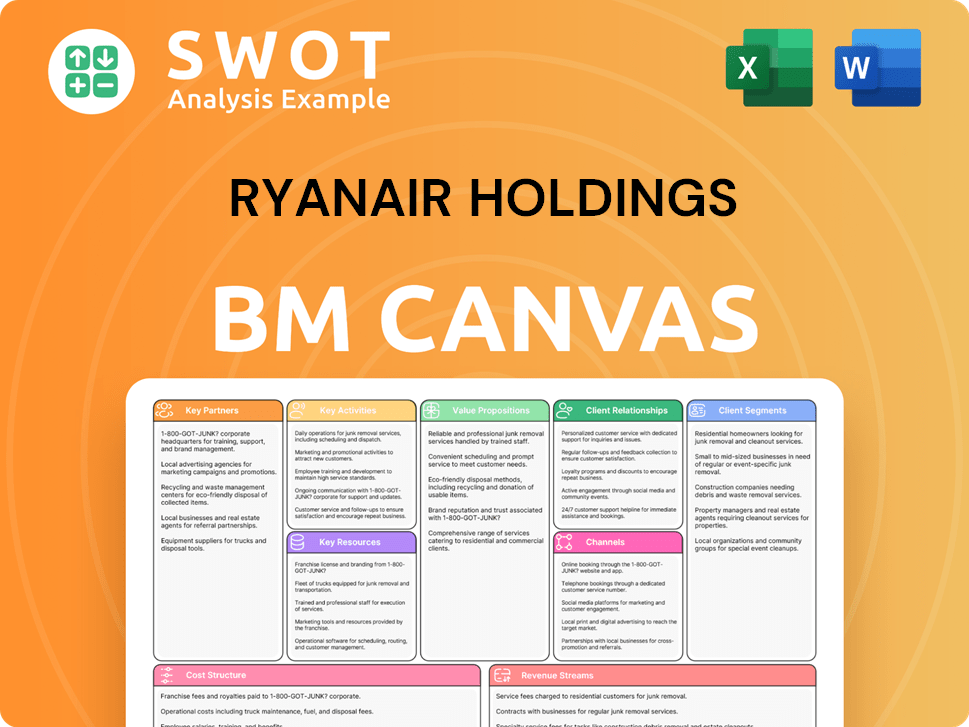
How Does Ryanair Holdings Win & Keep Customers?
Customer acquisition and retention at Ryanair are fundamentally shaped by its ultra-low-cost model. The airline concentrates its efforts on direct sales through its website and mobile app, which serve as the primary booking platforms. Digital marketing, encompassing SEO, PPC advertising, and email marketing, is crucial for driving traffic to these digital platforms. Social media is employed for brand awareness and customer engagement, often highlighting promotional fares and special offers. Traditional advertising is minimal, aligning with the company's cost-conscious approach. The sales tactics emphasize transparent pricing and the value proposition of low fares.
The strategy focuses on providing consistently low prices and the convenience of its extensive network, rather than a traditional points-based loyalty program. Personalized experiences are primarily delivered through its mobile app, offering streamlined booking, check-in, and flight information. After-sales service is largely self-service via digital channels, with customer support available for more complex issues. Ryanair leverages customer data to optimize pricing strategies and personalize offers for ancillary services, though it doesn't utilize complex CRM systems like full-service carriers. Successful acquisition campaigns often revolve around seasonal sales and flash promotions, generating significant buzz due to attractive price points. This strategy has remained consistent over time, with minor adjustments to incorporate digital advancements and cater to evolving customer expectations for online services, leading to high customer loyalty.
The primary focus of Ryanair's customer acquisition strategy is to attract price-sensitive travelers. The airline's marketing efforts are heavily geared towards digital channels, with a strong emphasis on driving traffic to its website and mobile app. This approach allows Ryanair to bypass intermediaries and maintain control over the customer experience. The consistent delivery of low fares is a cornerstone of its retention strategy, as it encourages repeat bookings and fosters customer loyalty. The airline's ability to offer attractive prices is a key factor in its success in the highly competitive European market.
Ryanair heavily relies on digital marketing. SEO, PPC, and email marketing drive traffic to its website and app. This strategy is cost-effective and directly targets budget-conscious travelers.
The company prioritizes direct sales through its website and mobile app. This strategy allows Ryanair to control the customer experience and keep costs down. This approach is fundamental to its low-cost model.
Instead of a traditional loyalty program, Ryanair focuses on offering consistently low prices. This strategy encourages repeat bookings and builds customer loyalty. The emphasis is on affordability.
The mobile app provides streamlined booking, check-in, and flight information. The app enhances the customer experience and offers personalized services. It is a key tool for customer engagement.
Ryanair's approach to customer acquisition and retention is centered on digital channels and operational efficiency. This strategy is designed to attract and retain price-sensitive customers. The airline's focus on low fares and direct distribution contributes to high customer loyalty.
- Digital Marketing: SEO, PPC, and email marketing drive traffic to the website and app.
- Direct Sales: Booking through the website and mobile app allows for cost control.
- Value Proposition: The focus is on consistently low fares and an extensive network.
- Mobile App: Streamlines booking, check-in, and flight information.
Analyzing Ryanair's customer demographics, it is evident that the airline primarily targets budget-conscious travelers. The Ryanair target market consists of leisure travelers, students, and individuals seeking affordable travel options. A Ryanair customer profile typically includes individuals who prioritize price over other factors, such as premium services or extensive in-flight amenities. The airline's marketing and operational strategies are designed to attract and retain this specific segment of the market. The airline's ability to offer low fares is a key driver of its success, particularly among price-sensitive consumers. For a deeper understanding of the marketing tactics, consider reading about the Marketing Strategy of Ryanair Holdings.
Ryanair Holdings Porter's Five Forces Analysis
- Covers All 5 Competitive Forces in Detail
- Structured for Consultants, Students, and Founders
- 100% Editable in Microsoft Word & Excel
- Instant Digital Download – Use Immediately
- Compatible with Mac & PC – Fully Unlocked
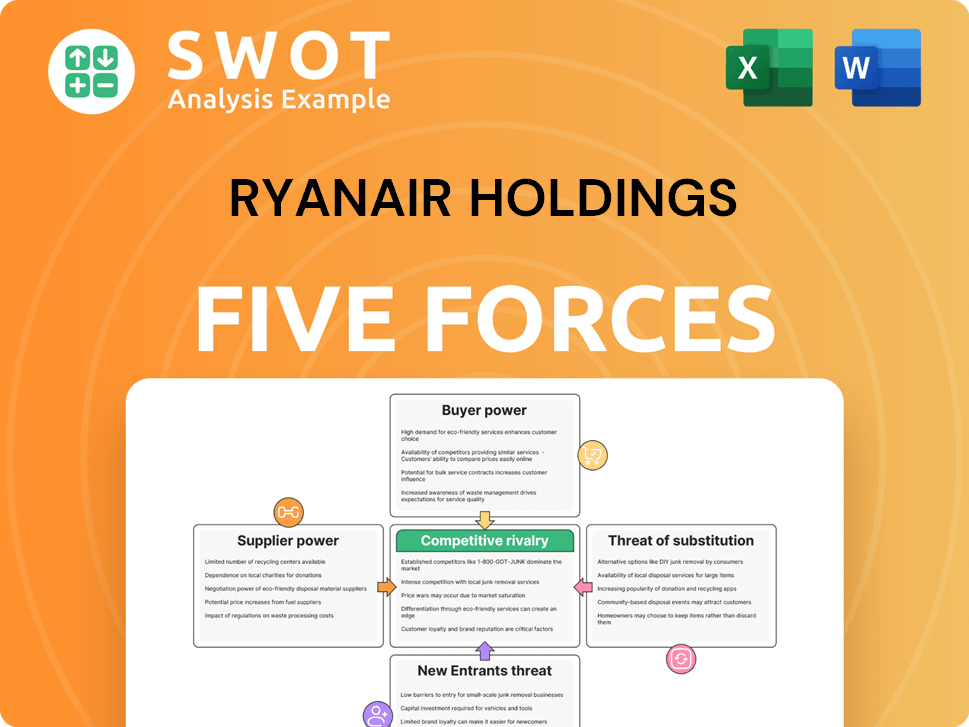
Related Blogs
- What are Mission Vision & Core Values of Ryanair Holdings Company?
- What is Competitive Landscape of Ryanair Holdings Company?
- What is Growth Strategy and Future Prospects of Ryanair Holdings Company?
- How Does Ryanair Holdings Company Work?
- What is Sales and Marketing Strategy of Ryanair Holdings Company?
- What is Brief History of Ryanair Holdings Company?
- Who Owns Ryanair Holdings Company?
Disclaimer
All information, articles, and product details provided on this website are for general informational and educational purposes only. We do not claim any ownership over, nor do we intend to infringe upon, any trademarks, copyrights, logos, brand names, or other intellectual property mentioned or depicted on this site. Such intellectual property remains the property of its respective owners, and any references here are made solely for identification or informational purposes, without implying any affiliation, endorsement, or partnership.
We make no representations or warranties, express or implied, regarding the accuracy, completeness, or suitability of any content or products presented. Nothing on this website should be construed as legal, tax, investment, financial, medical, or other professional advice. In addition, no part of this site—including articles or product references—constitutes a solicitation, recommendation, endorsement, advertisement, or offer to buy or sell any securities, franchises, or other financial instruments, particularly in jurisdictions where such activity would be unlawful.
All content is of a general nature and may not address the specific circumstances of any individual or entity. It is not a substitute for professional advice or services. Any actions you take based on the information provided here are strictly at your own risk. You accept full responsibility for any decisions or outcomes arising from your use of this website and agree to release us from any liability in connection with your use of, or reliance upon, the content or products found herein.